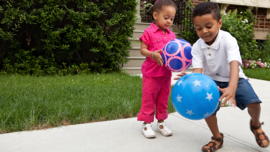All-important play

Give your child a cognitive leg up with play techniques that boost thinking skills.
What are executive functions? Executive functions are a set of mental processes thought to be responsible for our ability to plan, think flexibly, inhibit responses and monitor our actions, among many other skills. Anytime you rehearse a new phone number or resist the impulse to eat a cookie while you’re on a diet, you’re using parts of the executive system.
In the classroom, children call upon their executive functioning skills in many ways. A child who resists the urge to shout out the answer when another classmate is called on is using executive functioning to inhibit a response. A child who starts a homework assignment during free time so that she can watch TV later is using executive functioning to plan and delay gratification. The kindergartner who memorizes a series of steps in his daily routine—hanging up his backpack, picking his reading center book and sitting in his seat—is using executive functioning to follow rules.
Our executive functions, believed to reside largely in the prefrontal cortex of our brains, continue to develop throughout childhood and adolescence. We can develop strategies to help maximize some of our cognitive processes, including working memory. Working memory is what allows us to hold small amounts of information in mind while we make decisions or try to commit it to long-term memory. We can hold about 7 “things” (plus or minus 2) in working memory at one time, which is one reason for 7-digit phone numbers.
One strategy for improving our working memory capacity is to use a tactic called “chunking.” By chunking groups of relevant information together, we can hold far more than 7 individual items in our working memory. For example, when being asked to memorize the string of numbers 2, 0, 1, 2, we can rehearse them as four separate numbers, or we can chunk them together as one number representing the year 2012, allowing us to remember far more items at once.
Young children often have difficulty holding multiple-step directions in mind or recalling rules—especially when the rules change. These difficulties are related to their developing executive system. By being aware of children’s developing executive functions, you can manage your own expectations as a parent more appropriately, as well as find fun ways to foster their growth.
Tips & Activities
- Build one-, two-, and then three-step directions into a role-playing scenario. For example, if you’re playing “house” with your child, try suggesting that your child first take the toy milk carton out of the pretend fridge, and then pour the milk into the cups. If your child masters both steps, try adding a third step. Keep your instructions within the realm of your pretend world and encourage your child along the way. He’ll think he’s playing, but you’ll know you’re also supporting his cognitive development.
- Ask your child to sort toys into two buckets by a single rule, such as putting all the large toys in a large bucket, and all the small toys in a small bucket. Once your child has mastered this sorting challenge, invite them to play again, but this time switch the rules! Have them put the small toys in the large bucket, and the large toys in the small bucket. Chances are that if you have a young preschooler, they will be able to tell you the new rule verbally, but will forget to actually sort by it. This “game” mimics the Reverse Categorization Task, an executive functions task that requires working memory (to remember the rules), self- control (to inhibit the old rules), and cognitive flexibility (to do the opposite of what was learned previously). Keep practicing—they’ll get it, and best of all, they’ll have fun along the way.
- Play “Simon Says!” Your child will have to remember the rules of the game, self-regulate their behavior (copy the action only when hearing “Simon says”), inhibit the impulse to copy every action (i.e., when “Simon says” is not said) and shift their attention between what is said and how they need to respond (or note respond).











